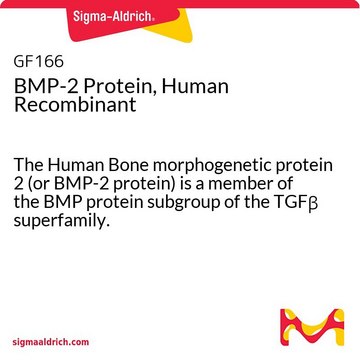B1814
BMP2, human
Carrier Free, ≥98% (SDS-PAGE), recombinant, expressed in E. coli, lyophilized powder, suitable for cell culture
Synonyme(s) :
Bone Morphogenetic Protein 2 human, BMP-2
About This Item
Produits recommandés
Nom du produit
Bone Morphogenetic Protein 2 human, Carrier Free, ≥98% (SDS-PAGE), recombinant, expressed in E. coli, lyophilized powder, suitable for cell culture
Source biologique
human
Niveau de qualité
Produit recombinant
expressed in E. coli
Essai
≥98% (SDS-PAGE)
Forme
lyophilized powder
Poids mol.
26 kDa
Conditionnement
pkg of 10 μg
Conditions de stockage
avoid repeated freeze/thaw cycles (Do not store in a frost-free freezer.)
Technique(s)
cell culture | mammalian: suitable
Impuretés
Endotoxin, tested
Couleur
white
Solubilité
water: soluble 0.100 mL, clear, colorless
Numéro d'accès UniProt
Température de stockage
−20°C
Informations sur le gène
human ... BMP2(650)
Vous recherchez des produits similaires ? Visite Guide de comparaison des produits
Actions biochimiques/physiologiques
Forme physique
Remarque sur l'analyse
Code de la classe de stockage
11 - Combustible Solids
Classe de danger pour l'eau (WGK)
WGK 3
Point d'éclair (°F)
104.0 °F - closed cup
Point d'éclair (°C)
40.0 °C - closed cup
Faites votre choix parmi les versions les plus récentes :
Certificats d'analyse (COA)
Vous ne trouvez pas la bonne version ?
Si vous avez besoin d'une version particulière, vous pouvez rechercher un certificat spécifique par le numéro de lot.
Déjà en possession de ce produit ?
Retrouvez la documentation relative aux produits que vous avez récemment achetés dans la Bibliothèque de documents.
Notre équipe de scientifiques dispose d'une expérience dans tous les secteurs de la recherche, notamment en sciences de la vie, science des matériaux, synthèse chimique, chromatographie, analyse et dans de nombreux autres domaines..
Contacter notre Service technique



